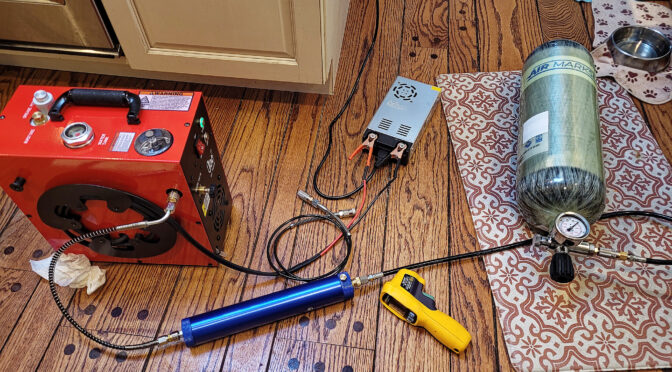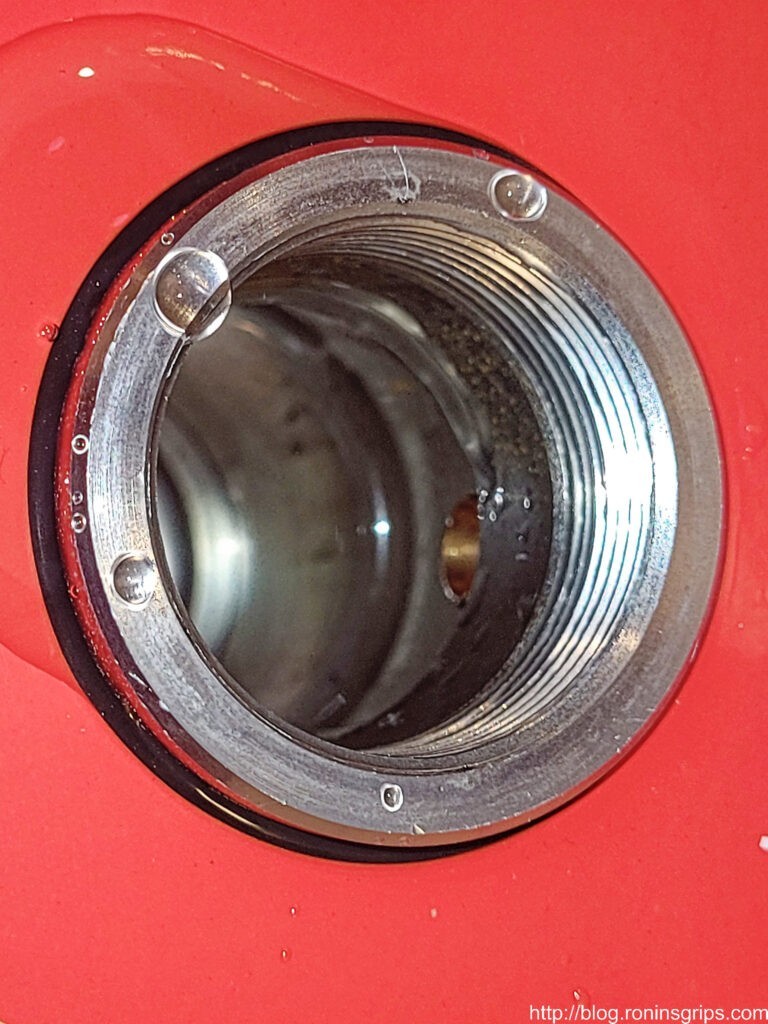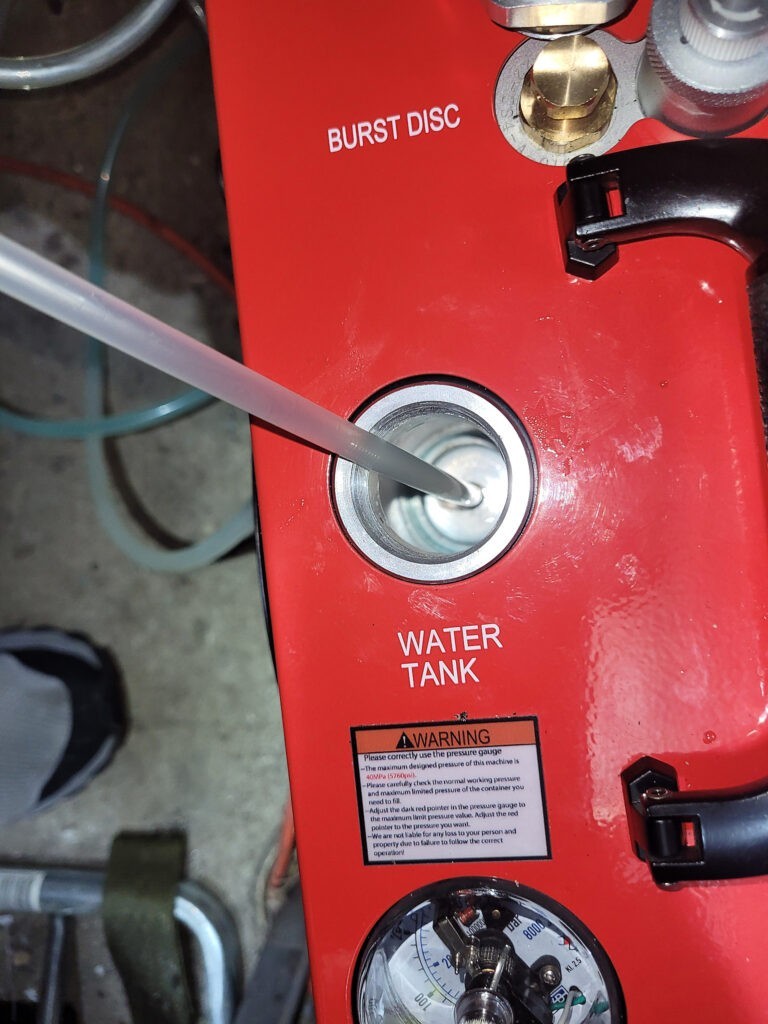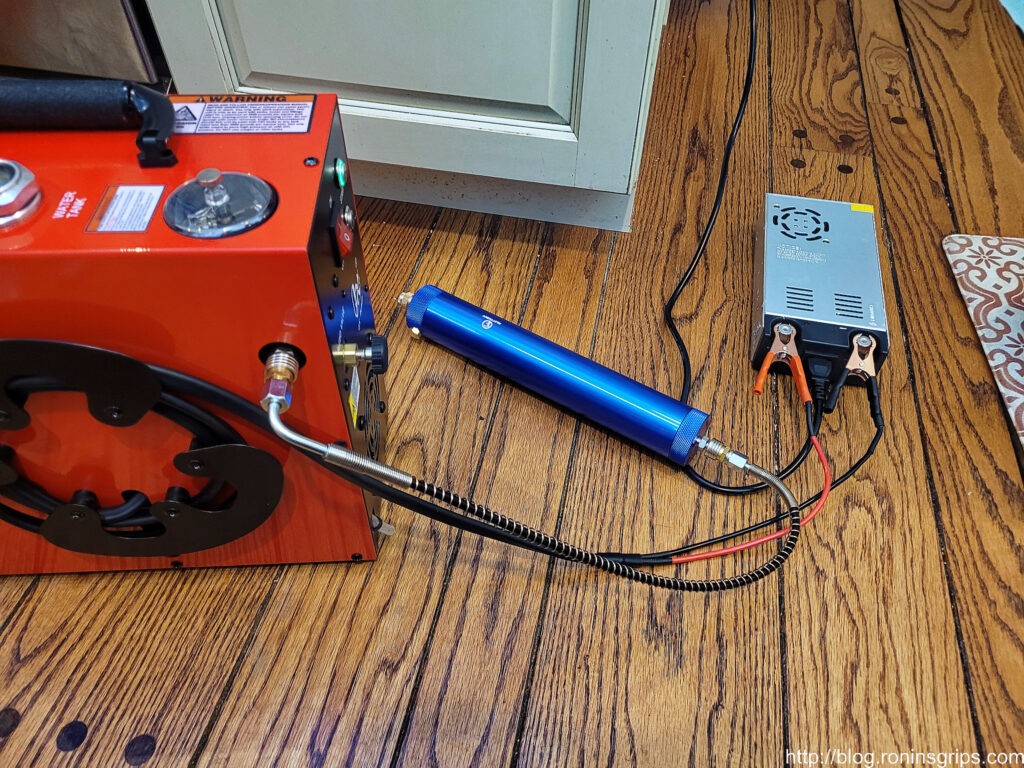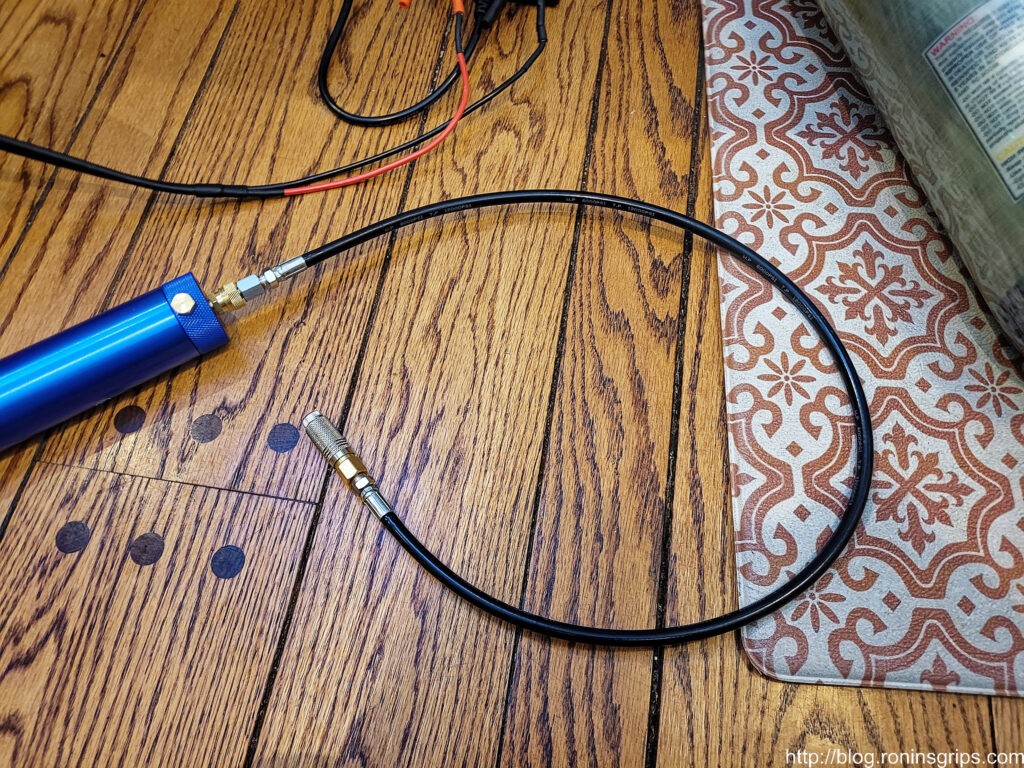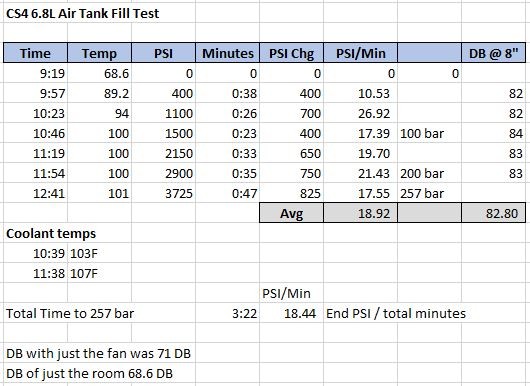In the last post I discussed purchasing a new GX CS4 compressor and showed you some photos of it out of the box. In this post, I want to give you some recommendations on setting the unit up and testing it. There are definitely details around the CS4 that you need to know and it is critical you don’t just take it out of the box and try to start using it.
Read the Instruction Pamphlet
There should be a small pamphlet in with the CS4. Take a minute and read the instructions for use. Afterwards read the following.
Distilled Water or Antifreeze for Cooling?
So the pump gets its really long duty cycle in no small part due to the liquid cooling system. Liquid is a far, far more efficient conductor of heat than air is. You see, water is much more dense than air and depending on the article you read it is 9 to 13 times more efficient at carrying away heat – maybe even more.
In the automotive world, to lower the freezing point and raise the boiling point, various chemicals have been discovered and are often referred to generically as “antifreeze”. You look deeper though and there are tons of variations for different manufacturers and different specifications.
GX said to use either distilled water or a PH-neutral antifreeze. Well, I wasn’t sure how hot the pump would get so I was worried about using distilled water. The benefits of distilled water is that it is cheap and it is PH neutral being neither acidic nor alkaline so it’s not going to cause excessive corrosion. On the other hand, it can freeze or boil like any other water plus there aren’t any corrosion inhibitors or pump lubricating agents.
I was very keen to use an antifreeze for longer life plus I was worried about boiling. I didn’t plan to keep the pump outside so freezing wasn’t a worry. The problem began when I tried to find “PH-neutral” antifreeze. I could not find any antifreeze with a true PH of 7. I turns out that you will be hard pressed to find it – I found cutting fluids (coolants for doing metal cutting) with a PH of 7, brake line antifreeze that had a PH of 7 — it was almost pure methanol, but not a thermal transfer fluid that I could buy in small quantities (like 1-2 gallons).
The more digging I did the more I realized that I could use an automotive antifreeze but needed to find one with a relatively low PH (7-9) and also that contained corrosion inhibitors and was aluminum and plastics & hose friendly. To make a long story short, this led me to Valvoline’s Zerex G48 coolant and I opted for a 70/30 mix of coolant to distilled water. My local Napa autoparts store was able to order in a gallon jug with same day in store delivery. It’s a fortune to mail order but only $14-17/gallon at a store.
Do not add it to the unit yet! You will need to test and flush the cooling system first
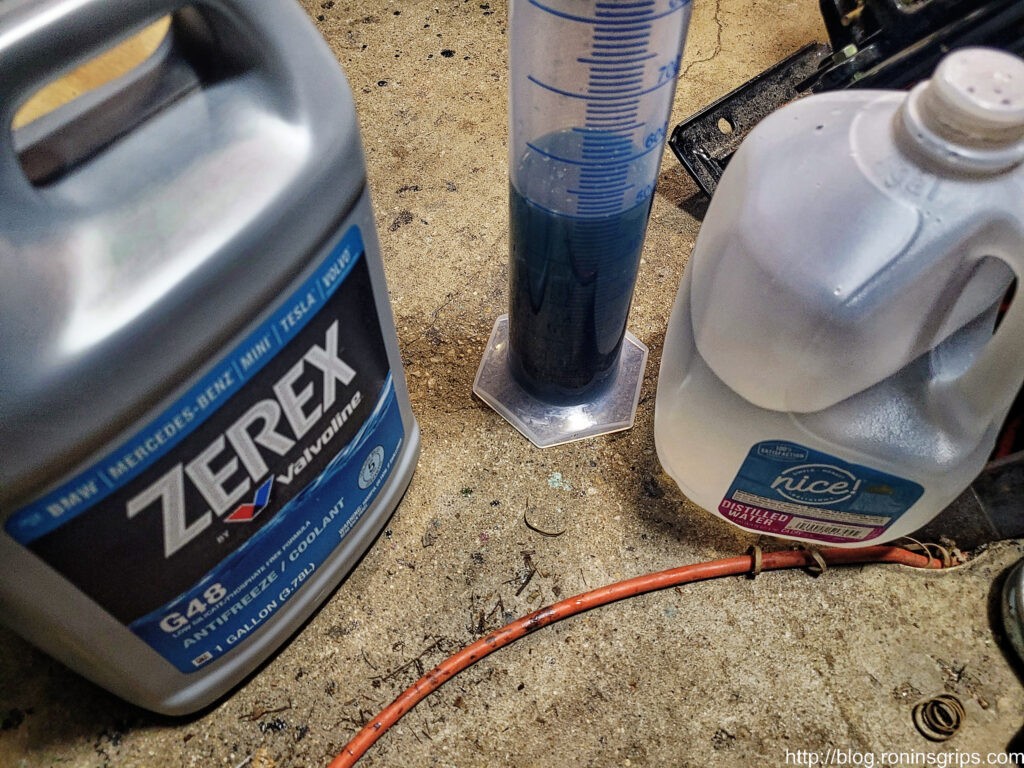
Powering It Up
Before you get to far, plug the AC-to-DC adapter in the wall. You should hear the cooling fan turn on — it definitely needs it so if you don’t hear the fan make sure there is AC power through the power cord to the adapter. There isn’t an on-off switch – the unit should turn on as soon as you plug it in.
Put a multimeter on the power supply terminals and you should see around 13 volts. My CS3 power supply is 13.16 volts and the CS4’s power supply which is the same model just newer measures 13.06 volts.
Make sure the CS4’s switches are off before you connect the compressor to the power supply.
Flushing the Liquid Cooling System
The nut with viewing glass that covers the water tank should just be on hand tight. If you must, use a wrench to remove it but just put it on hand tight when you re-install it going forward. The system is not pressurized – you can take the cap off while it is operating.
For some reason my CS4 shipped with a little bit of water in it – maybe from testing at the factory and there was also some kind of brownish sediment on the bottom of the “water tank”.
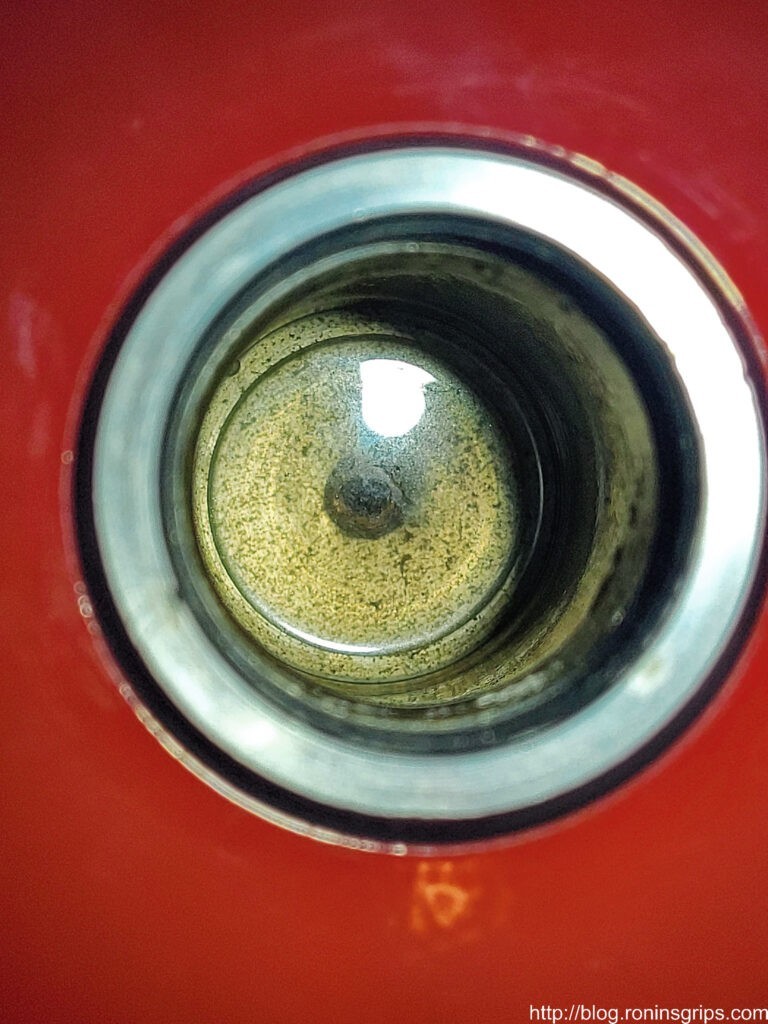
The liquid had no smell and felt like water – I have to guess it was water so I just dumped it out. I then refilled the tank with clean distilled water and swirled it around. I did this four times until the water stayed nice and clean.
For testing and flushing the system, just use distilled water. It’s cheap and doesn’t make a huge mess if there is a problem or something spills. Been there, done that – use water – trust me. By the way, purified water may not be distilled – the purified water might just be filtered. Distilled water uses a process that not only purifies the water but has the minerals removed as well. You don’t want minerals to leave a scaly buildup so use distilled.
I then turned the unit on and watched the water – nothing happened. There is a water pump – the intake is in the center bottom of the tank and the return is on the side about 3/4ths of the way up – there was no water moving. Oh man … I started to get really worried that maybe the water had frozen and snapped the pump but everything was dry when I took it out of the box … but …. stuff happens.
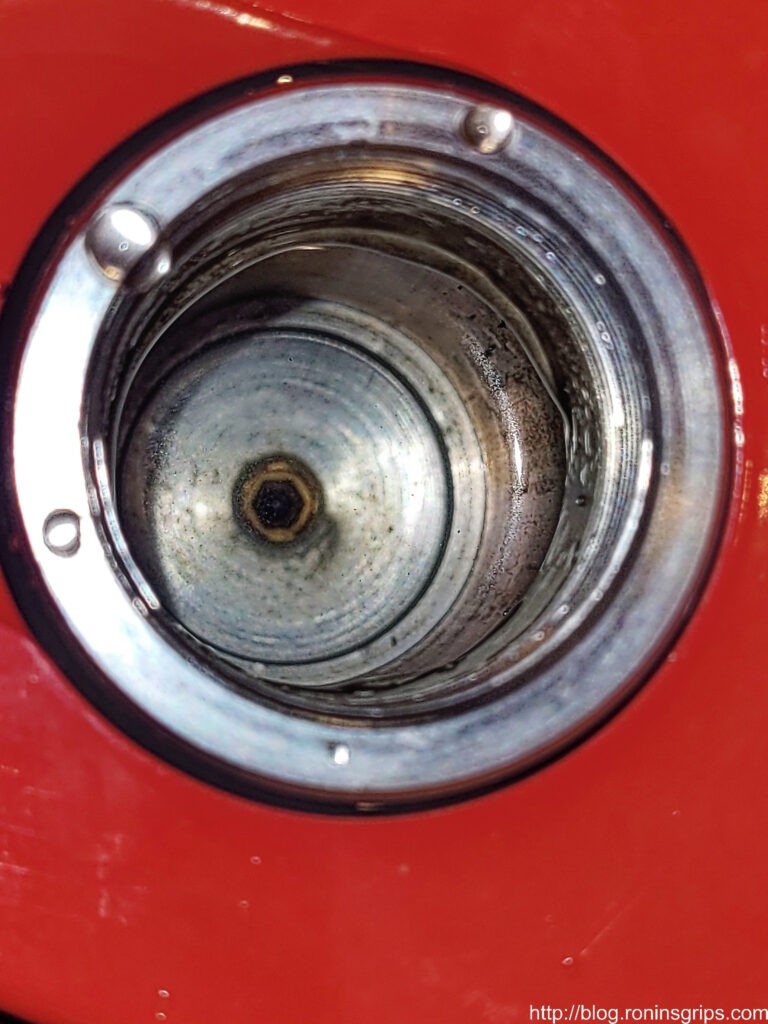
I started to take the case’s screws off to look inside. At one point, I leaned the unit part way over to get to a bottom screw and heard the familiar “glug glug glug” sound of water running into a void that previously had air in it. That was a very, very welcome sound because it dawned on me that the little water pump had lost its prime.
I looked at the water tank and the water level had definitely gone down. I turned on the pump’s main switch and the pump started moving the water! Lesson learned there – prime the pump.
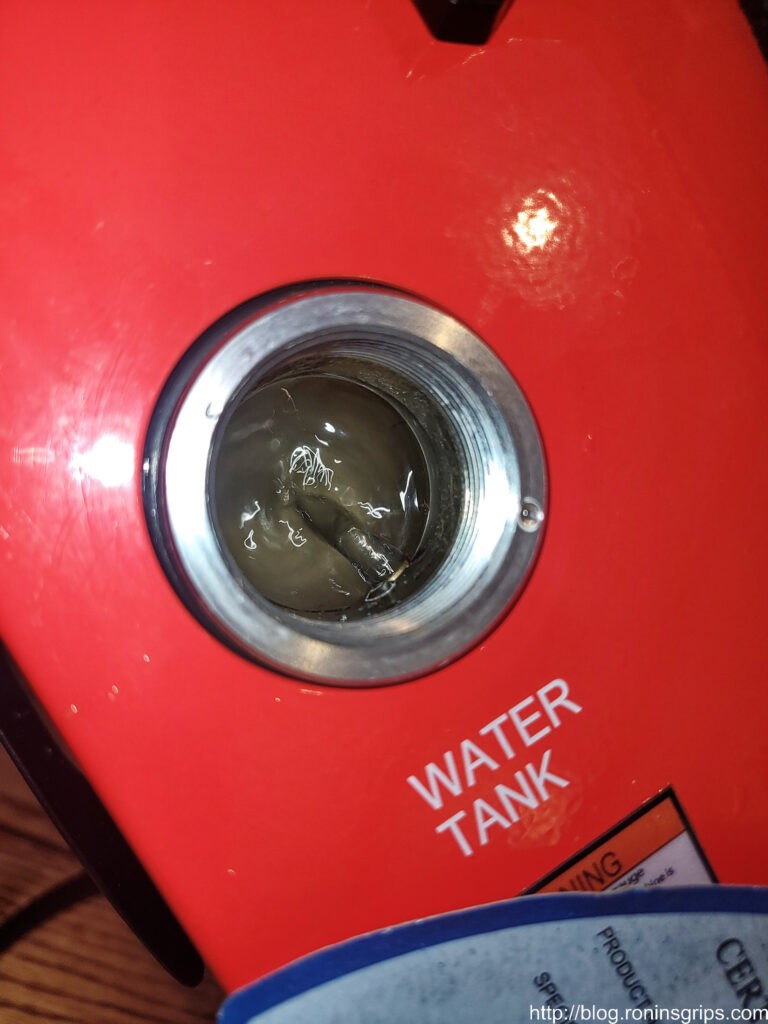
The next thing was that brown sediment was entering the tank as the lines blew out in the unit. I then dumped out the water and flushed the lines three more times until everything looked clear. Each time I would wiggle the compressor around leaning it slightly from side to side and front to back until the pump would prime. You fill the water tank to the bottom of the return line. This gives room for the coolant to expand and it also gives you a visual cue if the pump is working.
Now this told me something – there would be more water in the unit than just what was visible in the tank. In the instruction pamphlet they say you need to add 500ml of liquid to the unit. The unit came with some amount of water in it and each time when I drained the unit, I was only adding back in about 130 ml of water each time – I was using a 1000ml graduated cylinder for all of this. So, 500-130=370ml of trapped water in the system. Hmmm…. this was throwing my planned antifreeze ratios all off. 500ml of fluid at a 70/30 ratio would mean 350ml of antifreeze and 150ml of distilled water. I was going to be off and you need enough water in an antifreeze for the chemicals to move around properly.
In general, 100% pure antifreeze concentrate is a bad idea – there is a ratio you need to follow either based on the temperature range you need or what the vehicle manufacturer recommends. With G48, most vehicle makers recommend a 50/50 mix and there is actually a premixed formula with a typical PH of 8.1 (the range is 8-9). I was going for 70/30 to have as low of a PH as possible (pure G48 has a PH between 7.1-7.3) and to maximize corrosion protection.
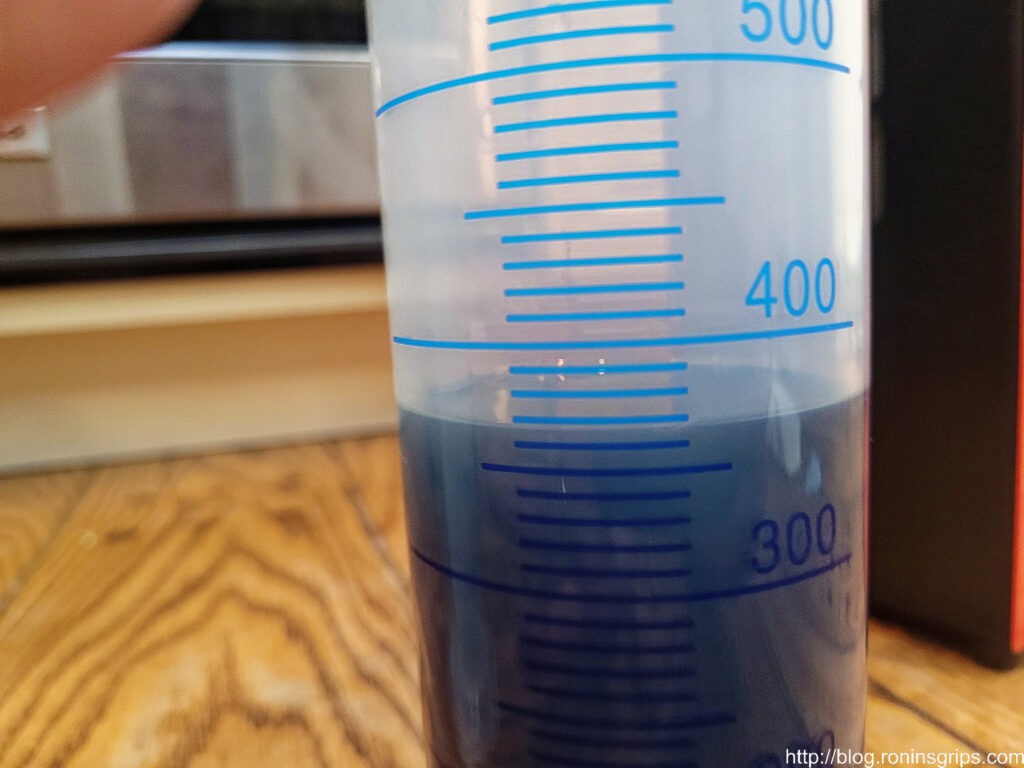
Well, the trapped water was throwing a wrench in my plans because I had already mixed the 70/30 not realizing I would have a bunch of extra water in the jacked and lines. Rather than drive myself nuts, I decided to go ahead and test the unit by draining out whatever water I could my tilting/moving the machine around while it was upside down and then refill with 70/30. After testing I will drain the tank get the antifreeze ratio closer to 70%.
I was not able to collect the final PH at this time. My test strips are absolutely useless with the dark blue of the G48 fluid. A friend has a calibrated digital tester that we will use some time in the future.
As I was writing this blog post, I was talking to my friend John, who is a master mechanic and has forgotten more than I will ever know, and told him about this. He didn’t even have to think about it – he said “pull a vacuum through the inlet or return and drain the system”. Duh. He was spot on – I sure hadn’t thought about doing that.
I used a MityVac MV-6830 brake line bleeder to suck all of the liquid out through the inlet. I put 70/30 in the tank and used a right angle adapter to pull all of the fluid that way. I then refilled the tank with 70/30 and pulled just enough vacuum to the point I saw fluid entering the hose and stopped – I did that last part to pull fluid into the pump.
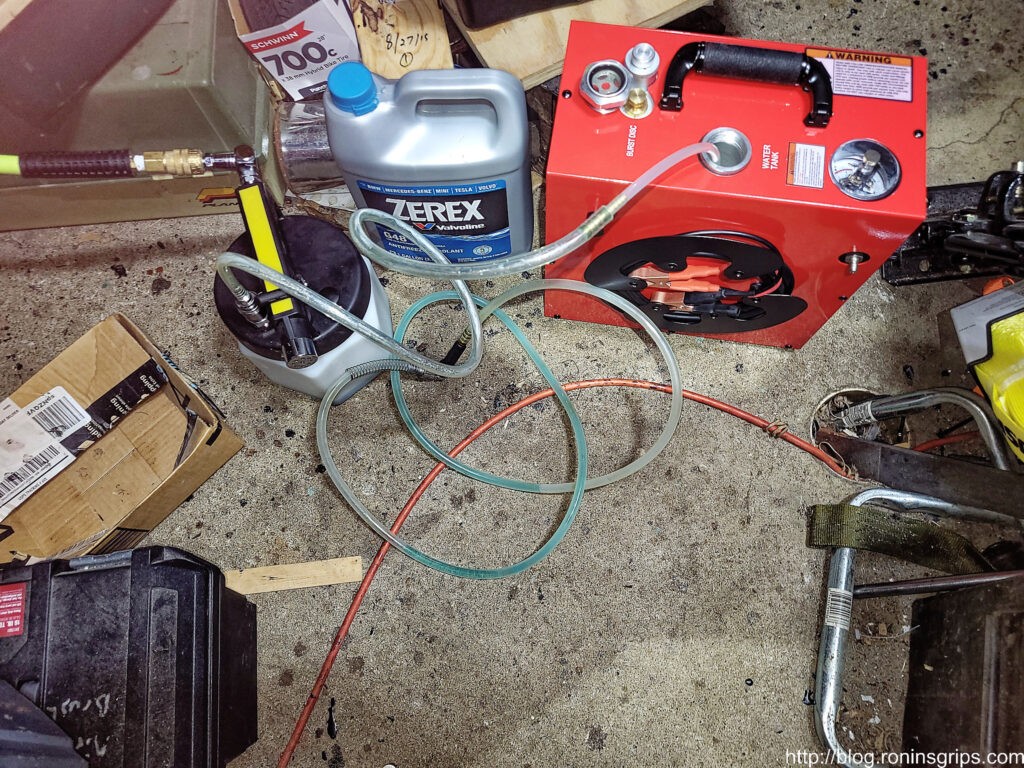
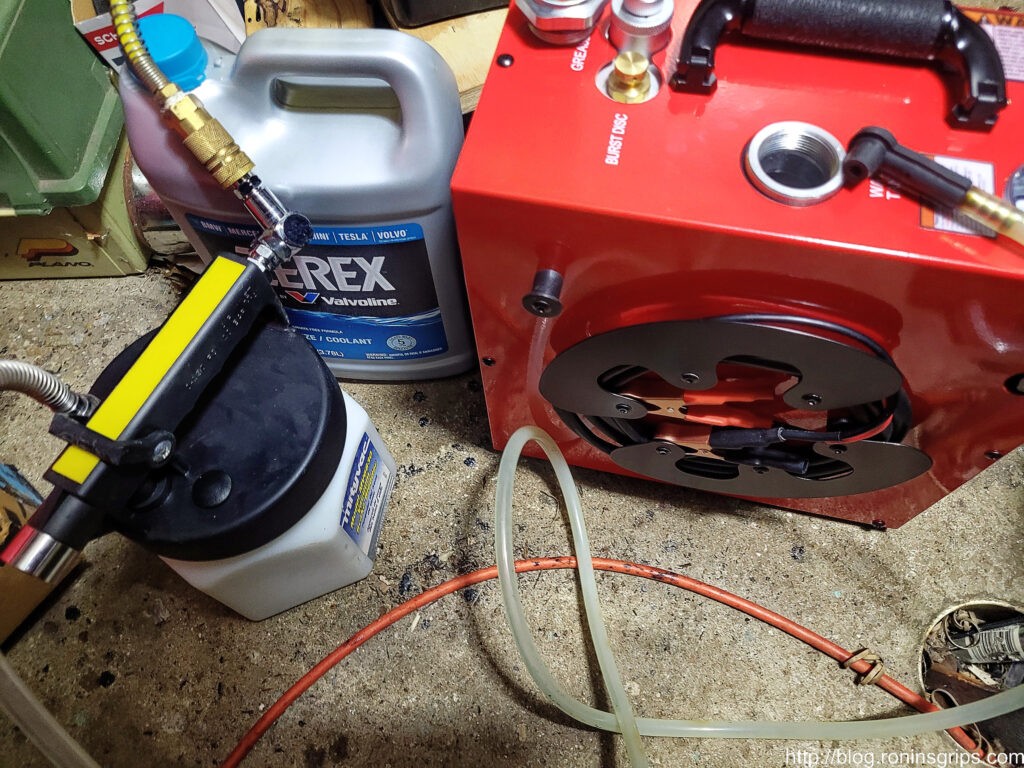
I then turned on the master switch so the fan and water pump would start. Nice clean 70/30 G48 was coming out. I slowly added more mix to the tank until I got to the bottom of the return line. I had to top it off just a tad maybe 2-3x as fluid filled little pockets. I let the unit run for another five minutes and when the fluid level stayed the same, I put the cap back on – done. It helps to have smart friends.
Here’s my lessons learned that I want to share when it comes to the cooling system:
1. Flush the cooling system out using distilled water and then use a vacuum bleeder or siphon tool to more fully drain the system. I put put about 250-350ml of fluid to fill the system in the end. The important thing is to fill the tank to the bottom of the return.
2. If you don’t see the fluid moving, you most likely need to prime the pump either by moving the CS4 around to work fluid down into the pump or draw it into it using a vacuum bleeder.
3. Test the cooling system with water – not antifreeze or you will make a mess plus water is cheaper.
4. While you can use distilled water, I would recommend Zerex G48 at either 70/30 or 50/50. I went with 70/30 that I had to mix from the concentrate.
Testing the CS4
Now that the critical coolant discussion has been addressed and you have filled the unit accordingly, let’s switch gears and start actually testing the unit. After every test, drain the unit using the bleed valve. I will bring this up again later but do not attempt to start the compressor with pressure already in the line.
| There will be some very high pressures involved. If a fitting does not want to come off, STOP. Many times a quick release collar will not move or a threaded fitting turn because the line is pressurized. Always make sure the line is depressurized before you work on it, remove a fitting, etc. |
Each bold heading below is a test I would recommend that you perform and if it fails, stop and contact the Amazon seller – Ankul. I am not a representative – just a user. With that said, here are the tests:
- Make sure the fluid pump is running
Before you start pressurizing the system, again, turn on the master red switch but not the pump. You should see the coolant circulating, If you do not, try moving the unit around to get the pump to prime
- Turn the compressor on with nothing attached
With the airline off and just the male foster fitting exposed with nothing on it, turn on the pump by pushing the top silver button. You should hear the pump start and feel air blowing out from the end of of the foster fitting rhythmically – there is a piston so the air will come out as the piston pushes upwards – it is not a continuous flow. You should not hear any awful grinding noises or banging sounds. Slight squeaks as things start to lubricate and wear in are possible – you are listening for “OMG – what the hell is that?” sounds.
Let it run for a minute or two and if no scary sounds start then shut off the compressor.
- Test with the supplied pressure hose only
To test high pressure air systems, always pressurize incrementally starting with the smallest thing first and work your way up to larger and larger volumes. In this case, start with just the air hose attached.
This is our first real test of the compressor under pressure plus we get to check the hose assembly. With that said, connect the air line and insert the test plug in the end. Make sure the plug is fully seated. Also, make sure the drain valve / pressure relief valve is closed – this is the black knob on the front of the unit. Clockwise closes the valve – it screws closed basically.
Set the limit switch / stop switch on the top to 300 bar. Put the secondary switch at 310/320 bar. I put my second switch just before 400bar but in hindsight, I would tell you to put it around 310/320.
Turn on the compressor by pushing the silver button. You should see the pressure build very quickly – the manual says it should reach the target 300 bar pressure in 38 seconds. I think mine was a bit faster than that.
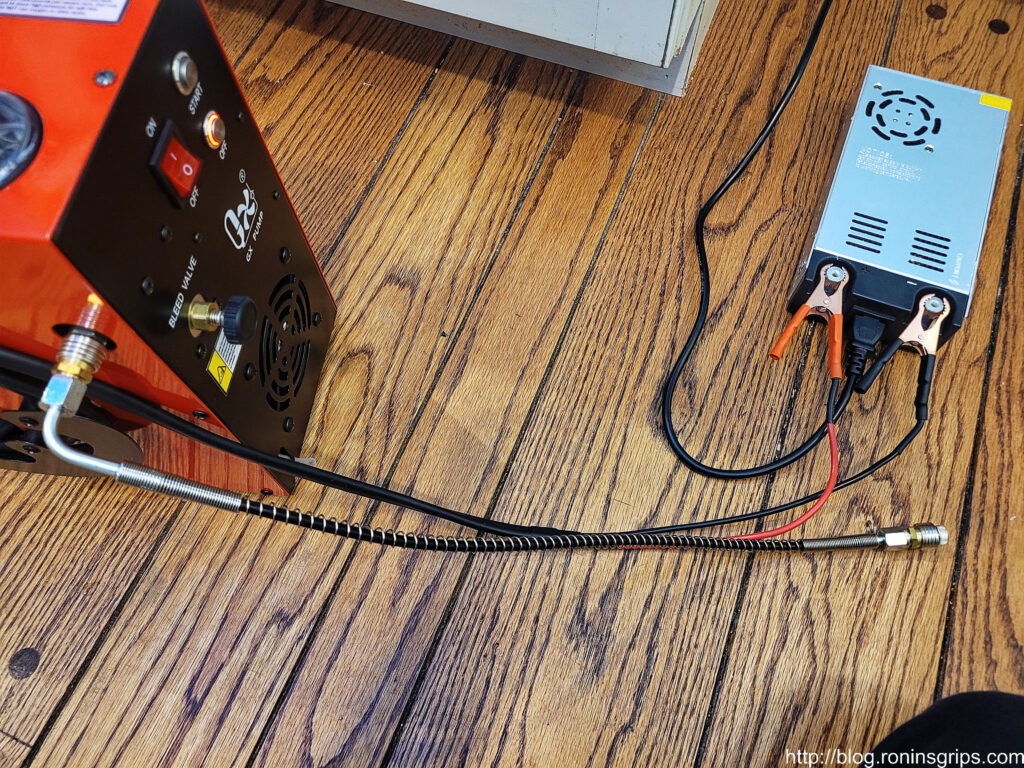
Now, don’t do a thing. Watch the pressure gauge. It should just sit there – if it is going down there is a leak. The most likely culprit is the drain valve isn’t fully closed. Wait until it leaks all the way down or open the bleed valve to speed things up. You don’t need to go crazy tightening the valve knob as you are liable to hurt something but it should be firmly closed. Make sure it is snug and try again. 90+% of the time that fixes the issue.
If it still leaks drain the system, remove the test plug and look in the female foster fitting – is the rubber o-ring still down in there? Same goes for the other end of the hose that plugs into the machine. It could be missing. So, if it is, insert an o-ring and try again. If the o-rings are there, sometimes just removing and reseating a quick connect fitting/plug can solve the issue. Make sure the bleed valve is closed and try again. If it will not build pressure, contact Ankul on Amazon.
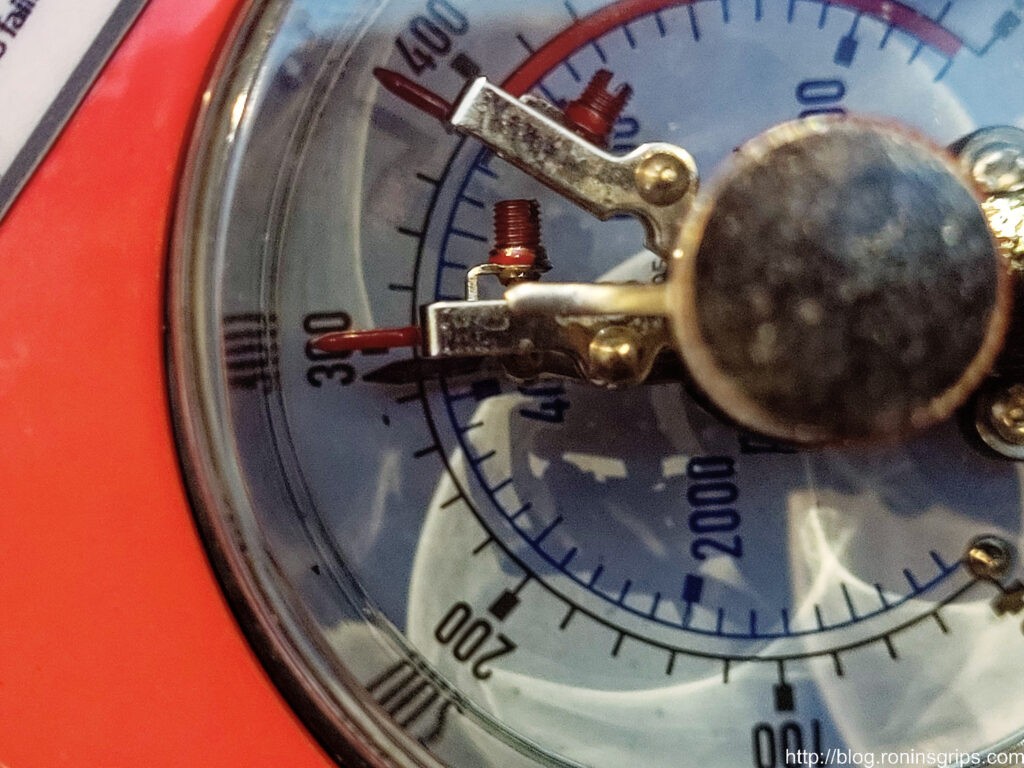
Soapy water in a spray bottle can help you find where the leak is at. Do not run your hands right against the fittings or you risk air getting injected into your body and that is very bad.
By the way, I let mine sit for about 3-5 minutes before I decide. Usually a leak is really obvious in the first minute – the first few seconds even. Either it will not build pressure at all or it leaks down fast.
Bleed off any residual pressure. Opening the bleed valve also allows any trapped moisture to blow out of the drain line also. I doubt you will see it with this short of a test but you will sooner or later so don’t worry. It’s supposed to do that.
- Test with the filter installed
Assuming the pressure line passes testing, it’s time to up the volume game and pressurize the air line and whatever external filter you want to run. I am using a big 300mm long filter with a 50mm outside diameter sold by FastToBuy on Amazon. Yes, the CS4 has an internal filter – but I really want the air to be dry.
First, make sure the system is depressurized by opening the bleed valve. Then plug your filter into the air hose and this time put the test plug on the end of the filter. All of your fittings should fit together very nicely. If you find something doesn’t want to go together, stop. Buy a replacement fitting, I like Air Venturi brand but any reputable brand will do. I’ve had Chinese no-name filters, hoses and other items with out of spec fittings that will not go together. Last month, I had a brand name fitting whip off a Hatsan Jet II and hit me in the glasses so hard that the polycarbonate lens was gouged and my glasses were flattened against my face on one side – I had tried to push the fittings together and they didn’t mate properly. Moral of the story – fitting should go together easily without forcing.
Once the assembly is together, the bleed valve is closed, set the pressure limit switches to 300 and 310 bar then turn on the compressor. It may take it a minute or two for enough pressure to build up to show on the pump’s pressure gauge. It may take a few more minutes depending on how big the filter is before it reaches 300 bar. As before – stop and watch the pressure gauge, it should hold steady and not leak down. If it does, then check the bleed valve, o-rings, etc.
The absolute most common source of leaks is at the fittings – worn or missing o-rings or one fitting not really sealing well against another and you then need to decide which fitting to replace. Soapy water in a spray bottle can help you find where the leak is at. Do not run your hands right against the fittings or you risk air getting injected into your body and that is very bad. Notice the repeat on that safety comment.
If everything passes, open the bleed valve to dump the air in the filter and line.
- Time to Fill The Tank
Part of my push for the new CS4 was to also fill my new 6.8L 4500 PSI Airmarksman tank. I really wanted to go with a new Omni or Patriot (US made Omnis) but the 6.8L model is hard to find so I went with Airmarksman because I really wanted two gauges – one with line pressure and the other with tank pressure. Standard single gauge units just show you line pressure.
It’s nice, the Air Marksman’s air hose attaches via a quick connect. I can go right from a female foster fitting on an airline right into the tank – no more little male-to-male quick connect fittings that are easy to lose.
I also bought a really nice 3′ long Manloney air hose extension to go from the new filter to the tank. In general, I am not a fan of hanging a filter right on a fitting because you create a long lever arm that is too easy to snag and break. Instead, I prefer a hose to the filter and then a hose from the filter into the tank.
You know what this means right? I tested the Manloney hose extension by inserting the test plug, and doing everything we’ve talked about previously.
I then bled the air off and let the unit’s cooling system run until the exhaust temperature was the same as surrounding surfaces because it was time to get real. Filling the tank from empty to 300 bar would take at least 2.5 hours and I wanted to record times, pressures, temperatures and and decibel readings along the way.
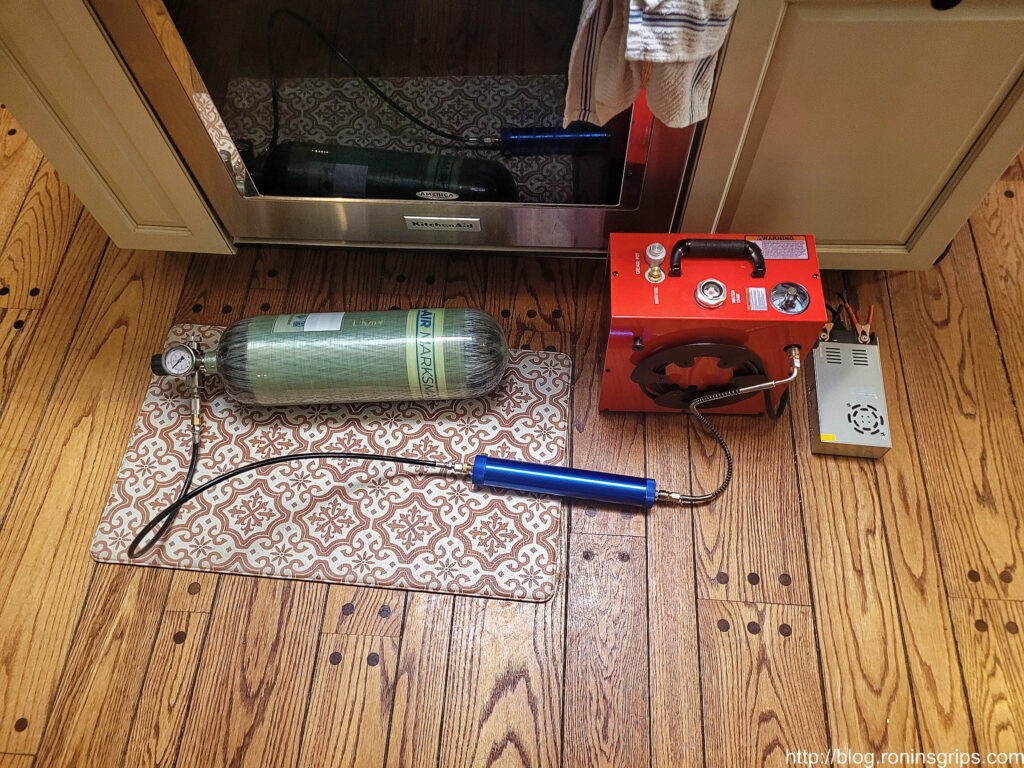
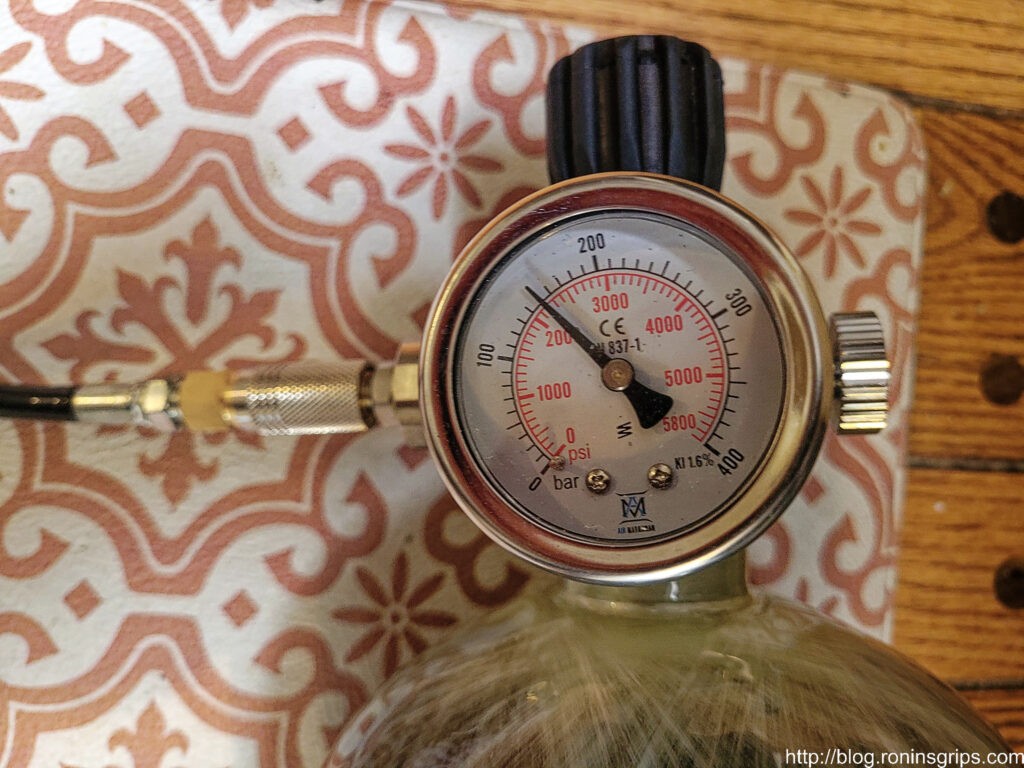
I couldn’t just sit next to the compressor and tank for the 3 hours and 22 minutes the test was running. I set the shut off on the pump to 300 bar but what I found was the needle you are moving around to shut off the pump is not precise. For example, I wanted 300 bar but what I got was 257 bar of 3,725 PSI. I then ran the unit another 10 or 15 minutes to take it up to 300 bar even and then moved the limit switch / shut off needle slowly backward until it stopped. Now the first switch is set where I want it. The second need is just behind it by about 10-20 bar.
The temperature management is remarkable. I was using a very good Fluke infrared thermometer to measure the exhaust fan area’s temperature and once it got up to about 100 degrees it pretty much stayed there once the unit warmed up. The noted coolant temperatures were collected by me removing the lid of the water tank and using the Fluke infrared thermometer to get a reading.
Speaking of temperature – this ran far cooler than I thought it would. I actually thought the fluid would get hotter and risk boiling. I still like using antifreeze for the corrosion protection and lubrication of the pump but boiling is not a concern and I don’t foresee it ever being some place where it could freeze but I guess lowering the freezing point is a good idea just in case.
In terms of sound, the unit turned on with just the fan and coolant pump running is 71DB according my BAFX 3608 decibel meter. The sound level with the compressor running was in the 82-84DB range about 8-10 inches from the side of the unit – not bad at all. I thought it might get louder as the pressure increased but it didn’t.
Last comment – the unit ran for well over 3 hours and thirty minutes – probably more like 4-4.5 with all of the testing. There were no funny sounds, no unexplained leakages, etc. That amount of running gave me a real good impression of the unit. After all of that running, I did turn the grease pot one rotation.
Special Note: DO NOT Start or Re-start The Compressor Under Load!
GX stated in multiple places to not try and start the pump with the system pressurized. I imagine it puts too much strain on the electric motor and other parts to get spinning. When I did the top off fill mentioned above, I closed the tank’s valve and opened the bleed valve on the compressor to depressurize the line. Unsurprisingly, maybe a teaspoon or two of water came out as well. I then closed the bleed valve, started the compressor and after it came back up to speed only then did I re-open the tank valve and put the system back under load.
By the way, I am not surprised by this at all. With shop air systems, part of the pressure limit switch is to also open a bleed off valve to depressurize the pump. It’s fairly common for these switches and valves to wear out. If the air doesn’t bleed off then a breaker may trip given the increased load. So, giving the CS4 a chance to start without a load and come up to speed first makes sense to me.
Summary
I was really impressed by the smaller CS3 model that I have used since November 2020. I bought this new CS4 model because I had such a good experience in fact and now that I have run the CS4 over four hours, I’m pretty happy. The CS4 will fill the niche in the GX line-up for a medium-duty machine for 6.8 Liter and smaller bottles. The CS3 will continue to be sold for people filling 1.5L or smaller cylinders.
Wrapping up – I really like the unit so far and will definitely post updates as time goes on.
Here are the GX compressors from the CS4 down to the CS1
- GX CS4 – 6.8L tanks, fluid cooled, longer run time, 5800 PSI/40Mpa – External 12 volt power supply [My current compressor]
- GX CS3 – 1 liter tanks, air cooled, 4500 PSI/30Mpa – External 12 volt power supply [I used this and now my friend has it]
- GX CS3-I – 1 liter tanks, air cooled, 4500 PSI/30Mpa – Internal power supply [I used the regular CS3 but they are the same other than the power supply]
- GX CS2 – .5 liter tanks, air cooled, 4500PSI/30Mpa – 12 volt or 110 AC [I have not used this one]
- GX CS1-I – .5 liter tank, air cooled, , 4500PSI/30Mpa, 12 volt or 110AC internal power supply [I have not used this one]
- FastToBuy 30Mpa Oil Water Filter – Not a GX product but I recommend this filter and you need one between the compressor and your tank or PCP airgun. You will need an extra hose from it to your tank or airgun plus the proper fittings.
Note, I have to buy all of my parts – nothing here was paid for by sponsors, etc. I do make a small amount if you click on an ad and buy something but that is it. You’re getting my real opinion on stuff.
If you find this post useful, please share the link on Facebook, with your friends, etc. Your support is much appreciated and if you have any feedback, please email me at in**@*********ps.com. Please note that for links to other websites, we are only paid if there is an affiliate program such as Avantlink, Impact, Amazon and eBay and only if you purchase something. If you’d like to directly contribute towards our continued reporting, please visit our funding page.
